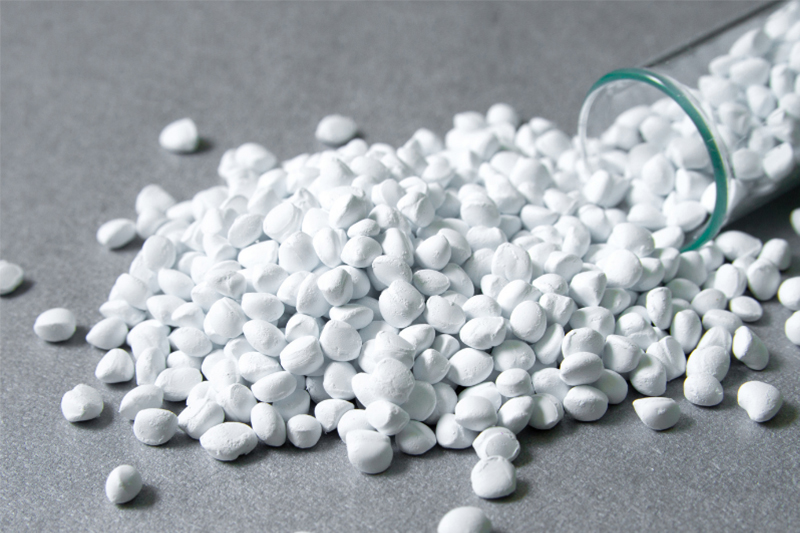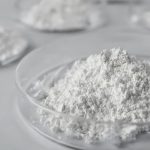
Mica
November 20, 2023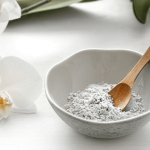
Talc
November 20, 2023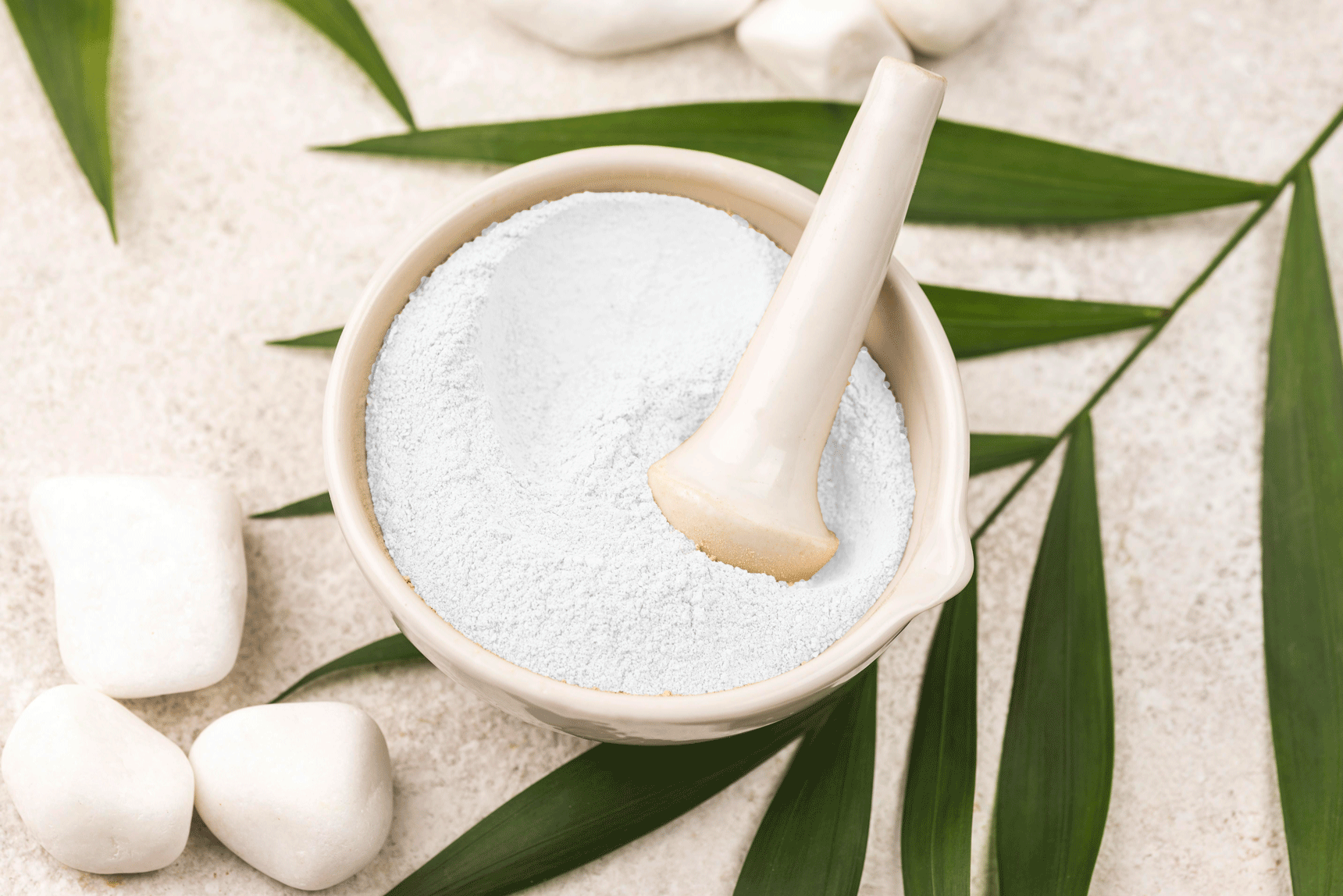
Calcium Carbonate
Calcium carbonate is a chemical compound with the chemical formula CaCO3.
This substance is common, found in rocks as the minerals calcite and aragonite, especially in gypsum and limestone, eggshells, snail shells, the skeletons of shellfish, and pearls. Substances containing a significant amount of calcium carbonate or similar are described as calcareous. Calcium carbonate is the active ingredient in agricultural lime and is produced when calcium ions in hard water react with carbonate ions to form lime deposits. It has medical applications as a calcium supplement or antacid, but excessive consumption can be dangerous, causing hypercalcemia and digestive problems.
Chemistry:
Calcium carbonate exhibits the common properties of other carbonates. It reacts with acids, releasing carbon dioxide (technically carbonic acid, but it rapidly composes into CO2 and H2O)
CaCO₃ (s) +2H⁺(aq) → Ca²⁺(aq)+CO₂(g)+H₂O(l)
Upon heating, it releases carbon dioxide, known as the thermal decomposition or calcination reaction. Above 840 degrees Celsius for CaCO₃, to form calcium oxide, CaO, usually called quicklime, with a reaction enthalpy of 178 kilojoules per mole.
CaCO₃ (s)→ CaO(s)+CO₂ ↑
Calcium carbonate reacts with water saturated with carbon dioxide, forming soluble calcium bicarbonate.
CaCO₃ (s) +CO₂ (g) +H₂O(l) → Ca(HCO₃)₂ (aq)
This reaction leads to the erosion of carbonate rocks, formation of caves, and water hardness in many areas.
An unusual form of calcium carbonate is the hexahydrate Ikaite, CaCO3·6H2O. Ikaite is stable only at temperatures below 8 degrees Celsius.
Preparation:
The vast majority of calcium carbonate used industrially is mined or quarried. Pure calcium carbonate (like for food or pharmaceutical uses) can be produced from a pure source (usually marble).
Alternatively, calcium carbonate can be made from calcium oxide. Water is added to give calcium hydroxide, then carbon dioxide is passed through this solution to precipitate the desired calcium carbonate, known in the industry as precipitated calcium carbonate (PCC). This process is called carbonation
CaO+H₂O → Ca (OH)₂
Ca(OH)₂ + CO₂ → CaCO₃ + H₂O
In the laboratory, calcium carbonate can be easily synthesized from calcium chloride (CaCl2) by placing an aqueous solution of CaCl2 in a desiccator next to ammonium carbonate ((NH4)2CO3). In the desiccator, ammonium carbonate is exposed to air and decomposes into ammonia, carbon dioxide, and water. The carbon dioxide then disperses in the aqueous solution of calcium chloride and reacts with calcium ions and water, forming calcium carbonate.
Structure:
The thermodynamically more stable form of CaCO3 under normal conditions is hexagonal β-CaCO3 (mineral calcite).
Other forms can also be prepared, orthorhombic λ-CaCO3 (2.83 grams per cubic centimeter) (mineral aragonite) and hexagonal μ-CaCO3, which occurs as the mineral vaterite.
The aragonite form can be prepared by precipitation at temperatures above 85 degrees Celsius. The vaterite form can be prepared by precipitation at a temperature of 60 degrees Celsius.
Calcite contains calcium atoms coordinated by six oxygen atoms. In aragonite, they are coordinated with nine oxygen atoms.
The structure of vaterite is not fully understood.
Magnesium carbonate (MgCO3) has a calcite structure, while strontium carbonate (SrCO3) and barium carbonate (BaCO3) adopt an aragonite structure, reflecting their larger ionic radii.
Polymorphism:
Calcium carbonate crystallizes in three anhydrous polymorphs; calcite is thermodynamically the most stable of these at room temperature, followed closely by aragonite, and vaterite has the least stability.
Crystal Structure:
The crystal structure of calcite is trigonal, with the space group R3̅C (number 167 in the International Tables for Crystallography), and Pearson symbol hR10.
Aragonite is orthorhombic, with the space group Pmcn (number 62), and Pearson symbol oP20. Vaterite is composed of at least two different crystallographic structures. The primary structure is in the space group P6₃/mmc, which shows hexagonal symmetry; the secondary structure is still unknown.
Crystallization:
All three polymorphs simultaneously crystallize from aqueous solutions under ambient conditions. In additive-free aqueous solutions, calcite easily forms as the primary product, while aragonite appears only as a minor product.
At high saturation, vaterite usually precipitates first, followed by its transformation to calcite. This behavior seems to follow the Ostwald Rule of Stages, where the least stable polymorph crystallizes first, followed by different polymorphs through a single crystal. However, aragonite, which lies in stability between vaterite and calcite, appears to be an exception to this rule, as it does not form as a precursor to calcite under ambient conditions.
Aragonite typically occurs when reaction conditions prevent calcite formation and/or promote aragonite nucleation. For example, the formation of aragonite is enhanced in the presence of magnesium ions or using proteins and peptides derived from biological calcium carbonate. It has been shown that certain polyamines, like cadaverine and poly(ethylene imine), facilitate aragonite formation over calcite.
Selection by Organisms:
Organisms such as mollusks and crustaceans have demonstrated the ability to grow all three crystalline polymorphs of calcium carbonate, primarily as protective (shells) and muscle attachment. Furthermore, they show a significant ability to select phases relative to calcite and aragonite, with some able to switch between these two polymorphs. The phase selection ability is usually attributed to the use of specific macromolecules or a combination of macromolecules by such organisms.
Geological Sources:
Calcite, aragonite, and vaterite are pure calcium carbonate minerals. Important industrial source rocks that are predominantly calcium carbonate include limestone, chalk, marble, and travertine.
Biological Sources:
Eggshells, snail shells, and most seashells are primarily calcium carbonate and can serve as industrial sources of this chemical.
Recently, shellfish shells have been recognized as a dietary calcium source, but they are also a practical industrial source.
Dark green vegetables like broccoli and kale contain significant amounts of calcium carbonate but are not practical as an industrial source
Extraterrestrial:
Beyond Earth, there is strong evidence of calcium carbonate on Mars. Signs of calcium carbonate have been identified in more than one location (notably in the Gusev and Huygens craters), providing evidence for the existence of liquid water in the past.
Geology:
Calcium carbonate is often found in geological environments and forms a massive carbon reservoir.
Calcium carbonate exists as aragonite, calcite, and dolomite, playing important roles in the calcium cycle.
Carbonate minerals form various types of rocks: limestone, chalk, marble, travertine, tufa, etc.
In warm, clear tropical waters, corals are more abundant than at the poles where the waters are cold.
Calcium carbonate agents, including plankton (such as coccoliths and planktic foraminifera), coral algae, sponges, brachiopods, echinoderms, bryozoans, and mollusks, are usually found in shallow water environments where sunlight and filterable nutrients are more abundant. Cold water carbonates exist at higher latitudes but grow very slowly. Calcification processes change with ocean acidification. Where the oceanic crust subducts under the continental plate, sediments are transferred to warmer regions in the asthenosphere and lithosphere. In these conditions, calcium carbonate decomposes and produces carbon dioxide, contributing to explosive volcanic eruptions.
Carbonate Compensation Depth:
The Carbonate Compensation Depth (CCD) is the point in the ocean where the rate of calcium carbonate precipitation balances with the rate of dissolution due to existing conditions. In the depths of the ocean, temperature decreases and pressure increases. Calcium carbonate is unusual because its solubility increases with decreasing temperature. Increased pressure also increases the solubility of calcium carbonate. The CCD can range from 4000 to 6000 meters below sea level.
Role in Taphonomy:
Calcium carbonate can preserve fossils through mineralization. Most vertebrate fossils from the Two Medicine Formation - a geology known for duck-billed dinosaur eggs - are preserved by permineralization with CaCO3. This type of preservation maintains high levels of detail even at the microscopic level. However, it also exposes the samples to weathering when exposed at the surface. It was once thought that trilobite populations constituted the majority of aquatic life during the Cambrian period because their calcium carbonate-rich shells were preserved more easily than other species with chitinous shells.
Applications:
The primary use of calcium carbonate is in the building industry, either as a building material or as crushed limestone for road construction, as an ingredient in cement, or as a raw material for lime production by burning in kilns. However, due to weathering, mainly from acid rain, calcium carbonate (as limestone) is no longer used alone for building purposes but only as a raw material for building materials. Calcium carbonate is also used in the purification of iron from iron ore in a blast furnace. The carbonate is calcined in situ to produce calcium oxide, which forms residues with various impurities and is separated from the purified iron.
In the oil industry, calcium carbonate is added to drilling fluids as a formation-bridging and filter-cake-sealing agent. It is also a weighting material that increases the density of drilling fluids to control the downhole pressure.
Calcium carbonate is added to swimming pools, as a pH adjuster to maintain alkalinity and neutralize the acidic properties of the disinfectant agent.
It is also used as a raw material in the sugar refining process from sugar beet. It is calcined with anthracite in a furnace to produce calcium oxide and carbon dioxide.
This burnt lime is then slaked in fresh water to produce a calcium hydroxide suspension for settling impurities in raw water during carbonation.
Calcium carbonate in the form of gypsum traditionally was the main component of blackboard chalk.
However, modern manufactured chalk is more often gypsum, hydrated calcium sulfate CaSO4·2H2O.
Calcium carbonate is the primary source for growing biogenic rocks.
Precipitated calcium carbonate (PCC), pre-dispersed in slurry form, is a common filler material for latex gloves with the aim of achieving maximum saving in material and production costs.
Ground calcium carbonate (GCC) is a crucial element in breathable thin film used in diapers and some building films, as the pores around the calcium carbonate particles are nucleated during the stretching of the film in two axes.
GCC and PCC are used as a filler in paper because they are cheaper than wood fibers.
Printing and writing paper can contain 10 to 20% calcium carbonate.
In North America, calcium carbonate has begun to replace kaolin in the production of glossy paper.
Europe has been doing this for several decades as part of alkaline papermaking or acid-free papermaking.
PCC used for paper filling and paper coatings is precipitated and prepared in various forms and sizes with a narrow particle size distribution and equivalent spherical diameters of 0.4 to 3 micrometers.
Calcium carbonate is widely used as an extender in paints, particularly in matte emulsion paint which typically contains 30% by weight of the paint of chalk or marble.
It is also a popular filler in plastics.
Common examples include around 15 to 20 percent chalk in unplasticized polyvinyl chloride (UPVC) drainage pipes, 5 to 15 percent chalk or marble coated with stearates in UPVC window profiles.
PVC cables can use up to 70 parts per hundred resin (phr) of calcium carbonate to improve mechanical properties (tensile strength and elongation) and electrical properties (volume resistivity).
Polypropylene compounds are often filled with calcium carbonate to increase rigidity and used at high temperatures, where the percentage is often 20-40%.
It is also typically used as a filler in thermoset resins (sheet and bulk molding compounds) and combined with ABS, among other materials, to form various types of products. In other cases, it is used for molding some types of ceramic poker chips.
Precipitated calcium carbonate made by dropping calcium oxide into water is used alone or with additives as a white paint known as whitening.
Calcium carbonate is added to a wide range of trades.
Tile and ceramic adhesives typically contain 70 to 80 percent limestone. Decorative crack fillers contain similar levels of marble or dolomite.
It is also mixed into putty used in glazing for colored glass and used as a resist to prevent glass from sticking to kiln shelves when firing glazes and paints at high temperature.
In ceramic glazing applications, calcium carbonate as whiting is known and is a common ingredient of many glazes in its white powdered form.
When a glaze containing this material is fired in a kiln, whiting acts as a flux material in the glaze.
Ground calcium carbonate is an abrasive (both as scouring powder and as an ingredient of household scouring creams), particularly in its calcite form, which has a relatively low hardness level of 3 on the Mohs scale of mineral hardness, hence it does not scratch glass and most other ceramics, enamel, bronze, iron, and steel, and has a moderate effect on softer metals like aluminum and copper.
A paste made from calcium carbonate and deionized water can be used to clean tarnish from silver.
In the pharmaceutical industry, it is used as an inert filler for tablets and other pharmaceuticals.
Calcium carbonate is used in the production of calcium oxide as well as toothpaste.
Agricultural lime, powdered chalk or limestone, is used as a cheap method for neutralising acidic soil, making it suitable for planting, also used in aquaculture to adjust soil pH in pond beds before planting.
Calcium carbonate is a key element in many household cleaning powders and used as a cleaning agent.

Application of calcium carbonate in sanitary porcelain
Application of calcium carbonate in pvc
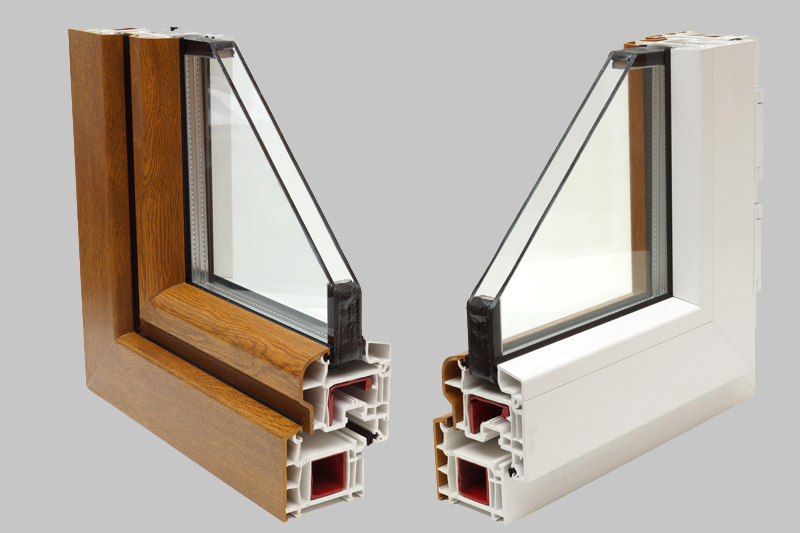

Application of calcium carbonate in wire and cable
Application of calcium carbonate in compound
